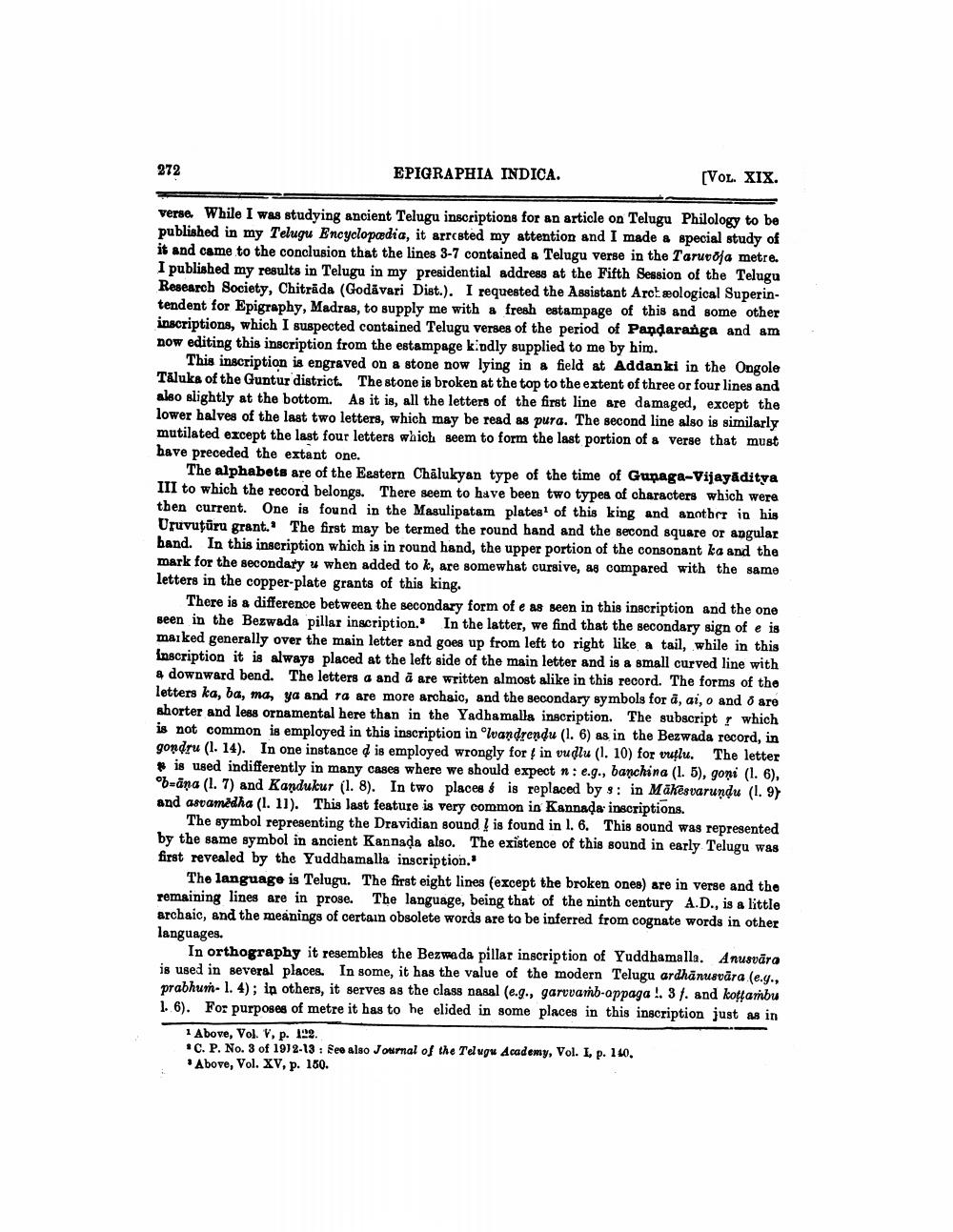________________
272
EPIGRAPHIA INDICA.
[VOL. XIX.
verse. While I was studying ancient Telugu inscriptions for an article on Telugu Philology to be published in my Telugu Encyclopædia, it arrested my attention and I made a special study of it and came to the conclusion that the lines 3-7 contained a Telugu verse in the Taruroja metre. I published my results in Telugu in my presidential address at the Fifth Session of the Telugu Research Society, Chitrāda (Godavari Dist.). I requested the Assistant Arctæological Superintendent for Epigraphy, Madras, to supply me with a fresh estampage of this and some other inscriptions, which I suspected contained Telugu verses of the period of Pandaranga and am now editing this inscription from the estampage kindly supplied to me by him.
This inscription is engraved on a stone now lying in a field at Addan ki in the Ongole Tāluks of the Guntur district. The stone is broken at the top to the extent of three or four lines and also slightly at the bottom. As it is, all the letters of the first line are damaged, except the lower halves of the last two letters, which may be read as pura. The second line also is similarly mutilated except the last four letters which seem to form the last portion of a verse that must have preceded the extant one.
The alphabets are of the Eastern Chalukyan type of the time of Gunaga-Vijayaditya III to which the record belongs. There seem to have been two types of characters which were then current. One is found in the Masulipatam plates of this king and another in his Uruvuţūru grant. The first may be termed the round band and the second square or angular band. In this inscription which is in round hand, the upper portion of the consonant ka and the mark for the secondary u when added to k, are somewhat cursive, as compared with the same letters in the copper-plate grants of this king.
There is a difference between the secondary form of e as seen in this inscription and the one seen in the Bezwada pillar inscription. In the latter, we find that the secondary sign of e is marked generally over the main letter and goes up from left to right like a tail, while in this Inscription it is always placed at the left side of the main letter and is a small curved line with a downward bend. The letters a and à are written almost alike in this record. The forms of the letters ka, ba, ma, ya and ra are more archaic, and the secondary symbols for a, ai, o and 8 are shorter and less ornamental here than in the Yadhamalla inscription. The subscript r which is not common is employed in this inscription in olvandrendu (1. 6) as in the Bezwada record, in gondru (1. 14). In one instance is employed wrongly for ( in vudlu (1. 10) for vutlu. The letter * is used indifferently in many cases where we should expect n:e.g., banchina (1. 5), goņi (1. 6), b=ana (1. 7) and Kandukur (1. 8). In two places $ is replaced by s : in Mākēsvarundu (1.9) and asvamedha (1. 11). This last feature is very common in Kannada inscriptions.
The symbol representing the Dravidian sound ! is found in 1. 6. This sound was represented by the same symbol in ancient Kannada also. The existence of this sound in early Telugu was first revealed by the Yuddhamalla inscription.'
The language is Telugu. The first eight lines (except the broken ones) are in verse and the remaining lines are in prose. The language, being that of the ninth century A.D., is a little archaic, and the meanings of certain obsolete words are to be inferred from cognate words in other languages.
In orthography it resembles the Bezwada pillar inscription of Yuddhamalla. Anusvāra is used in several places. In some, it has the value of the modern Telugu ardhānusvāra (e.y., prabhun- 1. 4); in others, it serves as the class nasal (e.g., garuvamb-appaga !. 31. and koftambu 1. 6). For purposes of metre it has to he elided in some places in this inscription just as in
1 Above, Vol. V, p. 122. *C. P. No. 3 of 1912-13 : Eee also Journal of the Telugu Academy, Vol. I. p. 140. Above, Vol. XV, p. 150.




